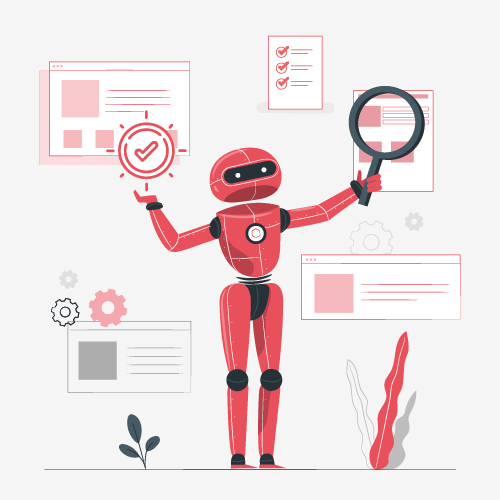AI in Quality Assurance: The Next Stage of Automation Disruption
If we sit to analyze the mobile app development journey ever since agile came into picture, we will find that the ways of how apps are delivered have completely changed.
Before the introduction of agile approach in mobile apps, there used to be a monthly or sometimes bi-monthly release. Ever since the approach has come into the picture, app releases have taken a weekly, bi-weekly approach.
To keep up with these frequent build releases, Continuous Testing was brought into existence and automation suits were built for sanity and regression testing. This new testing approach supported fast deliveries and even faster-paced testing cycles.
Now, with the world moving in the direction of Digital transformation, the need to anticipate market requirements in advance and developing a system that is scalable and predictive enough for catering to the future trends is at its climax. Moving beyond the continuous testing approach is now inevitable.
In the present situation, testing needs assistance for accelerating delivery. The role of artificial intelligence to improve quality control can help us reach there. A need for change is required in the manner quality assurance works in different companies. There are mainly two driving forces to continue quality assurance service– one is the agility in the manner testing is done (i.e. constant quality assurance) and second is the quicker time to market. For QA teams to stay up with the agile method of development, traditional test automation is not sufficient, thus making AI in test automation unavoidable.
In this article, we are going to look into the detailing of the role of AI in quality control. We will look into the different facets of AI in Quality Assurance: role of AI in quality management, the benefits of AI-enabled quality solution, the popular AI Quality Assurance tools, and the challenges associated with the integration of AI in mobile app testing.
Evolution of Quality Management Methods
Role of AI in Quality Assurance: Test Cases for Autonomous QA
Benefits of Using Artificial Intelligence in Testing & Quality Control
The Popular AI Testing Framework and Platforms
Evolution of Quality Management Methods
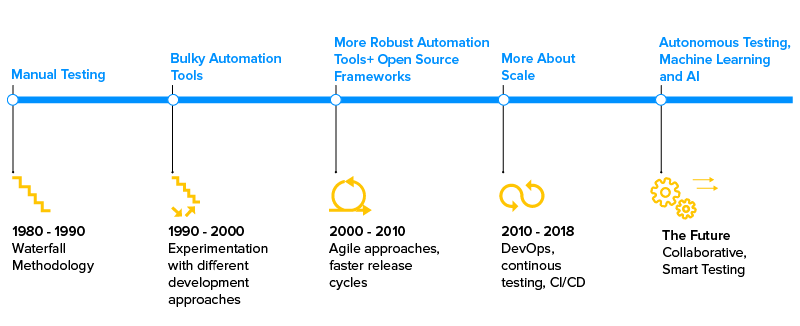
The Quality Assurance strategies have changed in today’s time. The ones that existed back in the 1980s have crossed several strides to keep up with the changing requirements of the software development and delivery approaches and cycle.
The present case, popularized as continuous testing, is dominated by the Agile and CI/CD approach. Even after being denoted as one of the most developed stages of software testing using artificial intelligence, continuous testing brings some key challenges in Quality Assurance workflow processes:
- Siloed automation
- An absence of end to end requirements visibility
- The high volume of test
To solve these issues, the industry must move to autonomous testing which ensures a zero-touch QA.
Role of AI in Quality Assurance: Test Cases for Autonomous QA
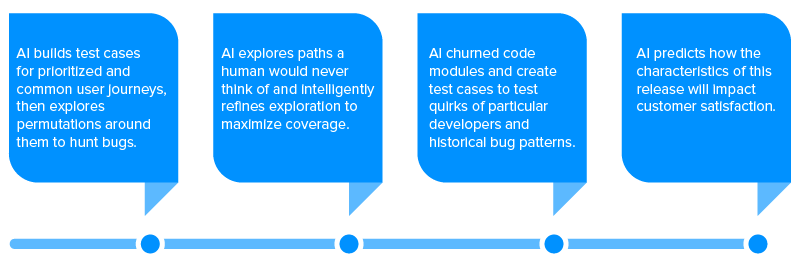
Incorporation of AI is what updates the QA process to its autonomous software quality assurance testing services stage.
Mobile app testing consists of a number of different tasks such as scripted automated testing, manual testing, and non-functional testing. The impact and role of AI in software testing can be seen adding value in the present testing efforts by enabling auto-exploring apps on actual devices for making sure that all of the functionalities and user flows work as they are supposed to.
The use of AI in testing can also help in identifying new bugs or defects which are introduced during the app exploration phase. The QA teams can make use of AI testing tools for supplementing normal testing efforts, while getting the best test coverage in expedited time and great accuracy.
The role of AI in quality assurance for machine learning and testing will also be seen in the testing tools where the tests will be enhanced with AI-powered visual verifications, which will give out a range of different outcomes.
If we explicitly talk about the test cases of AI in Quality Assurance, here are the ways testers are using AI presently –
- Implementation of AI through image-based testing
- Determining whether to run a test script
- Using AI spidering
- Monitoring API testing
- Automating tasks
With the active participation of AI and machine learning in Quality Assurance, the time to come will be extremely experimentation driven for the QA specialists.
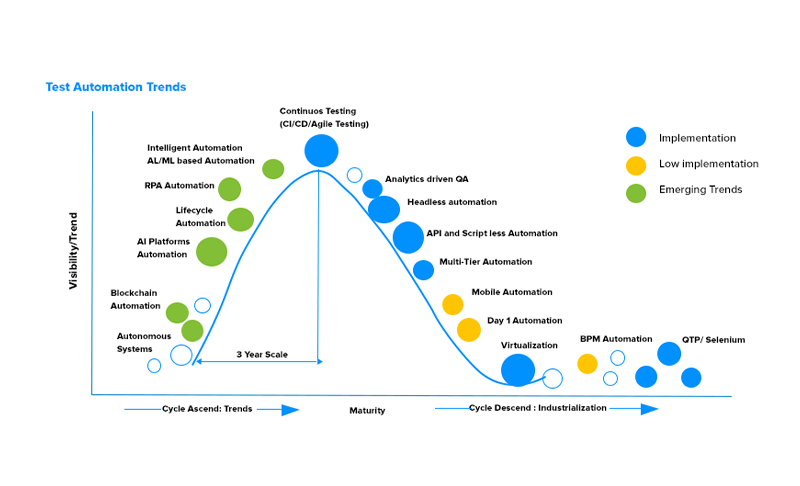
Benefits of Using AI Technology in Testing & Quality Control
Expedited timelines
There are many ways in which our team of developers speed up the app development process. Incorporating disruptions in the testing process is one of them. In place of going through thousands of lines of codes, AI will be able to sort through the log files, scan the codes, and detect errors within seconds. Additionally, AI lacks the burnout syndrome and thus yields better and more accurate results.
Also, AI can evolve with the code changes. It can adapt and identify new functions and can be programmed to decide if something is a new feature or a bug arising out of code change.
Well-Researched build release
By using Artificial Intelligence in Quality Assurance, it becomes possible for AI development companies to examine similar apps and determine what contributed to their success in the market. Upon understanding the market requirements, new test cases can be made for ensuring that the app doesn’t break when it comes to achieving specific goals.
Effortless test planning
Presently, a good amount of QA expert’s time goes into planning test case scenarios which otherwise would have got them app launch confidence. The same process has to be applied every time a new version is released in the market.
AI QA automation tools can help testers analyze the app by crawling through every screen while generating and executing test case scenarios for them, thus saving on the planning time.
Expanded role of a tester
With AI entering the picture, the teams of QA engineers will find themselves learning new skills. They will need to up their skills in neuro-linguistic programming, business intelligence, math optimization, and algorithmic analysis.
Job title wise, we can foresee these names coming into prevalence –
- AI QA Strategists
- AI Test Experts
- Data Scientists
Predictive analysis
AI can utilize existing client and examine data to determine how users’ necessities and browsing practice will advance. This permits testers, designers, and developers to be in front of developing users’ standards and offer better help quality. With ML, the platform consisting AI will improve with analysed user behaviour and give progressively more exact forecasts.
Improved regression testing
With fast deployment, there is always an increased need for regression testing, and sometimes the testing is to the point where it is impossible for people to practically keep up. Organizations can utilize AI for more tedious regression testing tasks, where ML can be used to create test contents.
In the case of a UI change, AI/ML can be utilized to scan for color, shape, or size. Where these would otherwise be manual tests, AI can be utilized for approval of the progressions that a QA tester may miss.
Visual user interface testing
AI helps in the visual approval of website pages. AI can test different contents on the UI. These tests are difficult to automate, typically needing human intervention for making a decision about design. Nonetheless, with ML-based visualization tools, contrasts in pictures are seen in a way that would not be feasible for people to pinpoint. AI testing removes the manual effort of modernizing the Document Object Model (DOM), constructing a structure and profiling risks.
The Six Levels of AI QA Testing
Level zero:
At this stage, writing the code is a repetitive process. Hence, adding a field to the page would mean adding a test. In a clearer manner, adding any form to a page means adding a test that checks all the fields. Adding a page means looking at all the components and forms through a whole new test.
The more the tests, the greater are the instances of you failing to ensure the app’s functionalities as a whole. To solve this, you check all the failed tests to know whether something is a bug or a fresh baseline.
Level one:
At this level, the better the AI is applied to your application, the more autonomous your QA will become. AI should not just look at the page’s Document Object Model but also its visual picture. Once the testing framework sees the page holistically, it will help you write checks which you otherwise had to write manually.
Today’s AI technology can help you with writing the test code by writing the checks. Also, they can check whether a test passes. If it fails, it should notify you so that you are able to check if the failure is real or happened because of a software change.
Level two:
Through Level One, the QA specialist would avoid the time-taking aspect of writing checks, while you can also use the AI for testing the visual elements of the page. But what follows – checking every test failure – is a tedious task.
At this level, your AI understands the differences in terms which the app users would also be able to understand. Thus, it will be able to group the changes from a number of pages, as it understands them semantically.
At Level 2, AI can tell the tester when the changes made are the same and ask whether it should accept or reject the changes as a group.
Level three:
In the previous level, human intervention is still needed for vetting any change or failure detected in the app. At Level 3, AI does the job.
For example, by applying the machine learning techniques, AI can examine visual elements of the app and decide if the UI is off, on the basis of the standard rule of design.
The AI at this level can evaluate pages minus human intervention, simply by understanding the data and design rules. It would look at hundreds of results and analyze how things change over time. Then, with the help of machine learning, it’d be able to identify differences in changes.
Level four:
Till now, humans have still been driving the tests. Level 4 is where AI would take over.
Since Level 4 AI is able to examine an app semantically and understand it like a human would, it can drive the tests. This AI will be able to see the user interactions over time and visualize the interaction, understand the page and user flow.
Once AI understands the page type, it will use reinforcement learning techniques to start driving tests, automatically.
Level five:
This part is out of a science novel right now. At this stage, AI will be able to communicate with the product manager, understand the app, and drive the tests – all by itself.
While presently, AI is still on Level 1, there are some automation events that are already using Artificial Intelligence: Visual UI testing, API testing, Automated quality assurance and testing, and Spidering.
The Popular AI Testing Framework and Platforms
Although slow but Quality Assurance has been making an entrance and prevalence in the third wave of automotion with the help of AI-driven quality assurance platforms.
Here are some of the top AI test automation tools and platforms operative in the market today to answer the most asked question, how AI tools can improve quality assurance?
Test automation tools
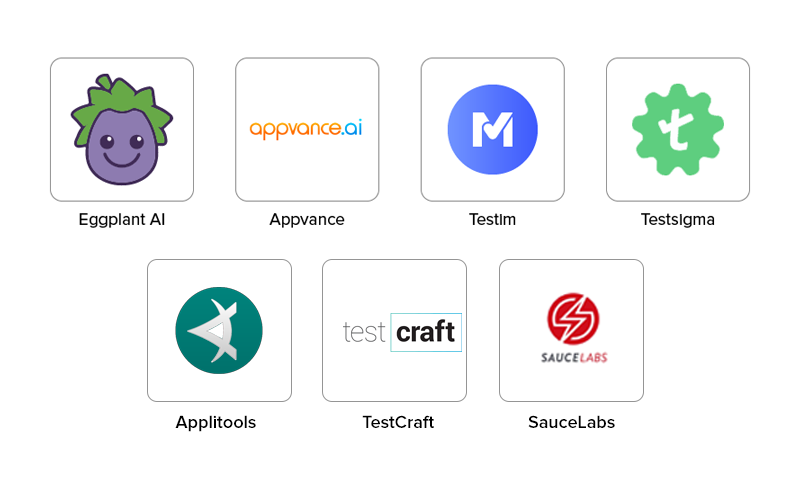 Eggplant AI
Eggplant AI
It makes use of intelligent algorithms for navigating software, predicting the many defects, and solving the challenges through the help of advanced data correlation. It also enables automating of test automation engines and provides graphical analysis of test coverage and outcomes.
Appvance
The platform provides software’s deep analysis through machine learning and delivers “app blueprints” models which apply cognitive generation. These blueprints hold the capability to develop multiple test cases in only a few minutes. Appvance also comes with a Test Designer functionality that can be combined with screenshot comparison, data driven tests, and AJAX or DOM auto capturing.
Testim.io
Uses of AI and machine learning for authoring, execution, and maintenance of the automated tests is done by this tool. It focuses on functional end-to-end and user interface testing. The platform continuously becomes smarter and the stability of its test suites increases with more runs.
Testsigma
It is one of the most commonly used AI-driven tools for continuous automated testing. The platform makes use of natural language testing processing for writing quality auto tests. It also identifies relevant test cases for test run and saves sudden test failures.
Applitools
With this tool there is no need to set up any visual processing settings, percentages or configurations to create visual testing. The tool automatically understands which changes are more likely to be bugs and which are the desired changes and then prioritize differences.
TestCraft
It is an AI-powered test automation platform for continuous and regression testing. With TestCraft testers can visually create automated, Selenium-based tests using a drag and drop interface, and operate them on several browsers and work environments, simultaneously.
SauceLabs
It is a robust cloud based tool that leverages ML and AI. The tool is said to be the world’s biggest continuous testing cloud that offers around 900 combinations for browser and operating systems along with thousands of real devices.
AI platforms
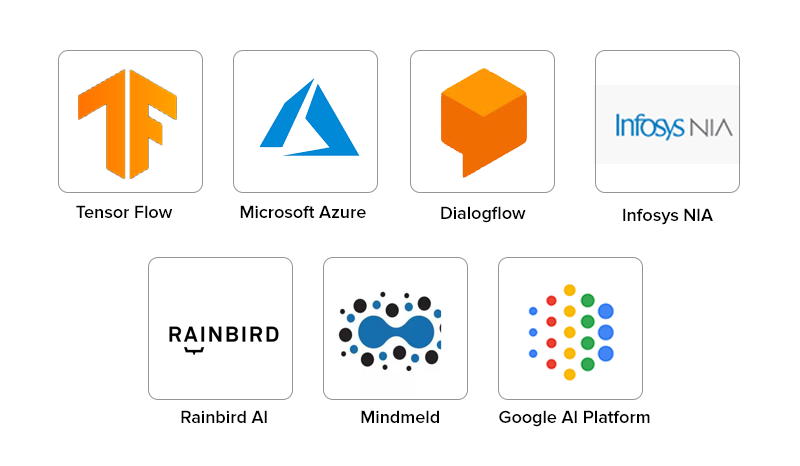 Google AI platforms
Google AI platforms
It is an end-to-end platform that helps you build application-specific models and improve existing model architectures with an automated AI software development service. From ideation to production to deployment, the platform helps developers to build and run their own ML apps.
Tensor flow
It is an open source software library that has comprehensive and flexible tools, libraries, and community resources that lets developers deploy computation to one or more CPUs/GPUs in desktop, mobile device, or server with a solo API.
Microsoft azure
A public cloud computing platform that provides cloud services like computing, analytics, storage, and networking. It is known as a backup and disaster recovery dream tool due to its flexibility, advanced site recovery, and built-in integration.
Dialogflow
This platform is a natural language understanding platform that makes it simple to plan and design a conversational UI into a mobile application, web application, bot, device, interactive voice response framework, and so forth.
Infosys NIA
The next-generation integrated AI platform is a knowledge based platform. With its unified, flexible, and modular platform, Nia allows a wide set of industry and function-specific solutions and enables customers to create custom experiences to fit their business needs.
Rainbird AI
The Rainbird platform uses AI-powered automation technology to have smart decision-making and smooth customer experience. The platform has an open-architecture so that it is integrated effortlessly with other solutions and APIs.
Mindmeld
This new generation conversational AI platform is streamlined for building conversational assistants which show profound understanding of a specific use case or domain while giving exceptionally valuable and flexible conversational experiences.
Bottom Line
There is no clear answer to which platform is the best, as every platform and tool have their own distinct features and uses. But if you need any help with streamlining your app development or understanding the quality assurance role then you can contact our expert team and ask out your doubts.
With our global platform, that is, AI development company in USA, Asia and other countries, we assist our customers and clients to leverage the latest technology to the utmost and provide better ROI for your business.

strategies your digital product..
